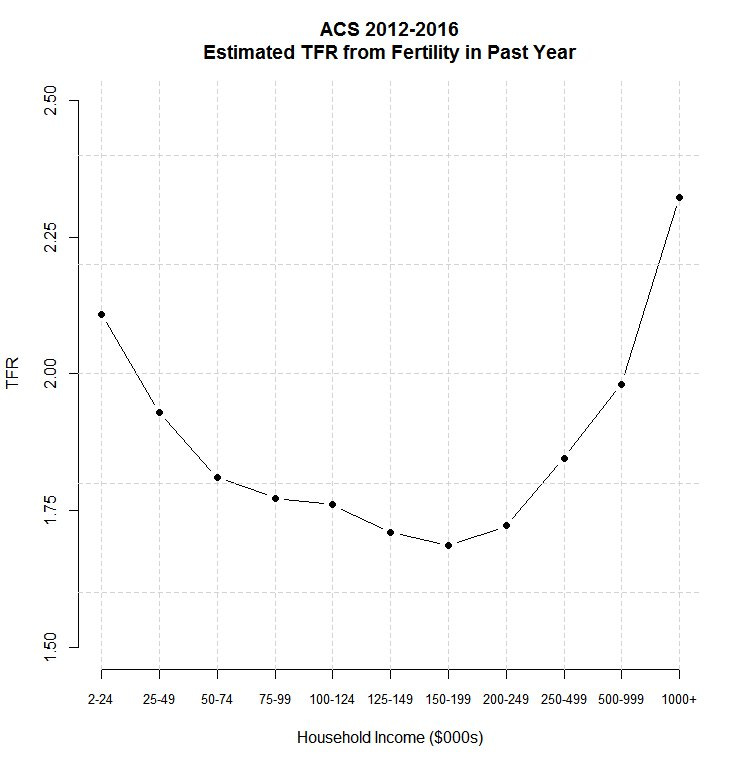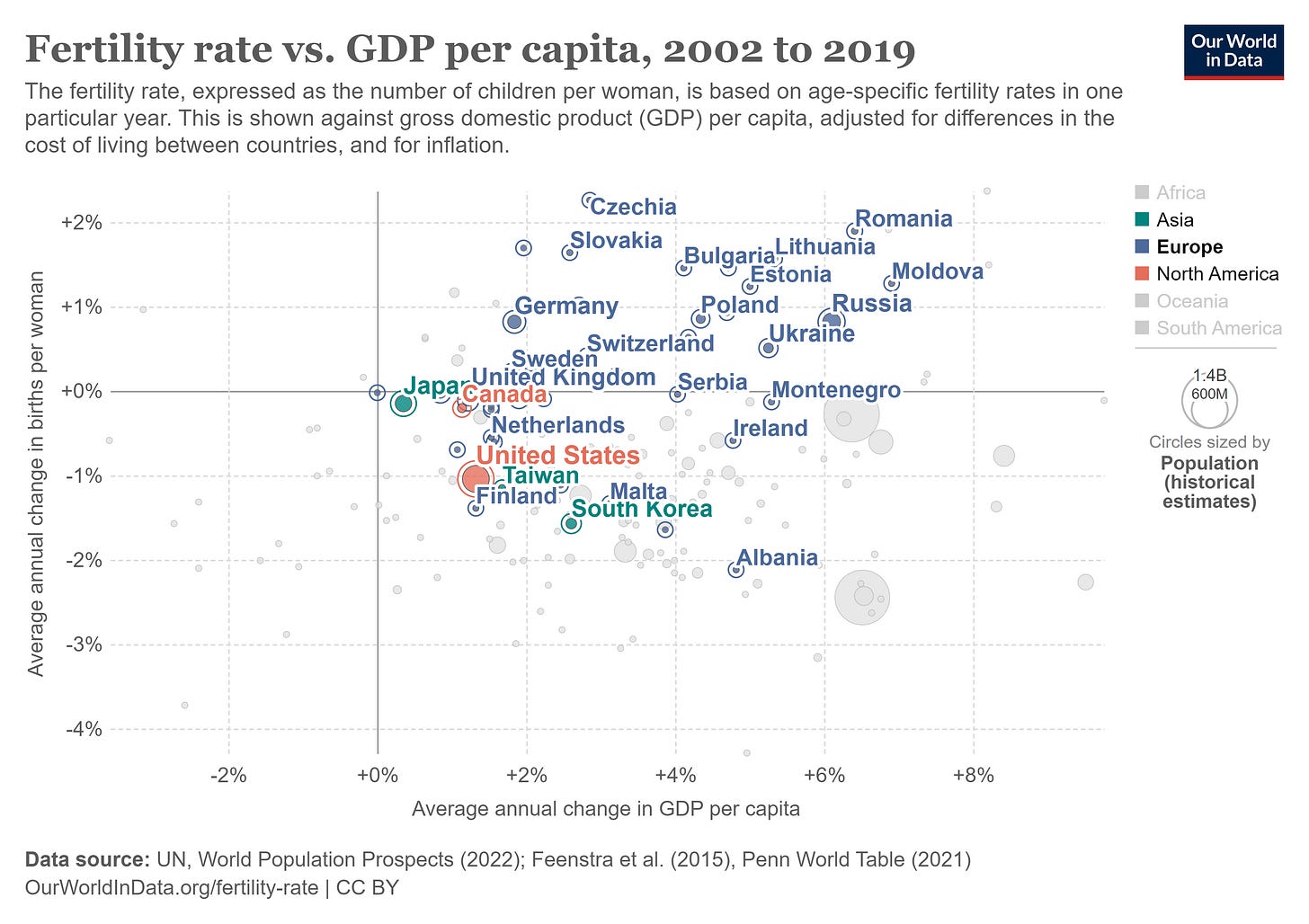The 2nd Demographic Transition
Opportunity cost and fertility
Birth rates in the developed world are below replacement levels and global fertility is not far behind. Sub-replacement fertility leads to exponentially decreasing population. Our best models of economic growth suggest that a shrinking population causes economic growth and technological progress to stop and humanity to stagnate into extinction.
One theory of fertility decline says it’s all about opportunity costs, especially for women. Rising labor productivity and expanded career opportunities for potential parents make each hour of their time and each forgone career path much more valuable. Higher income potential also makes it cheaper for parents to gain utility by using financial resources to improve their children’s quality of life compared to investing time in having more kids. Simultaneously, economic growth raises the returns to these financial investments in quality (e.g education).
In addition to higher incomes, people today have more diverse and exciting options for leisure. DINKs can go to Trader Joes and workout classes on the weekend, play video games, watch Netflix, and go on international vacations.
These rising opportunity costs accumulate into the large and pervasive declines in fertility that we see in the data.
If this explanation is correct, it puts a double bind on the case for economic growth. Unless AI upends the million-year old relationship between population and technological progress just in time, progress seems self defeating. The increases in labor productivity and leisure opportunities that make economic growth so important also siphon resources away from the future contributors to that growth. Empirically, the opportunity cost of having kids has grown large enough to bring fertility well below replacement levels all around the world. The opportunity cost explanation suggests we have to pick between high incomes and sustainable fertility.
Luckily, this explanation is not correct. At least not entirely. There are several observations that the opportunity cost theory cannot explain without clarification. Across and within countries today, the relationship between income and fertility is positive or U-shaped. Further economic growth can raise everyone’s incomes to the upward sloping part of the relationship and begin a 2nd demographic transition.
Micro Data
Above a $200k a year, fertility is increasing in household income.
** Update **
I replicated this graph from more recent ACS data (2018-2022) and also weighted each point by population to give a sense of the size of each of these income brackets
This U-shaped relationship holds up in multiple data sources with different measures of fertility. The households in the top percentiles of income stand to lose far more future wages from having children, but they have ~20 more children per hundred households than the middle income percentiles.
This isn’t exactly inconsistent with opportunity cost but it requires some explanation. The number of dollars that households are giving up by having children is increasing in household income, but as you get more and more dollars, each one is worth less. Going from making say $75 to $150 dollars an hour pushes you to work more hours, but if you go from $150 to $500, you might be happy to work half as many hours for more money and spend the time on other things, like starting a family. So while the dollar opportunity cost of having kids is always increasing in household income, the utility opportunity cost is not.
The positively sloped section of the relationship between income and fertility isn’t just spurious correlation either. Random shocks to wealth, like lottery winnings, also increase fertility.
This rules out the DINK leisure time explanation for low fertility too. High income households have access to the world’s best leisure opportunities, yet they still invest more time in child-rearing than lower income households. The time investment is even more upward sloping than the graph above shows because higher income parents spend more time on child care per-kid.
I think the explanation here is that childcare is a complement to many leisure activities rather than a substitute. Experiencing the joys and wonders of the world is better when you can experience them with and through your children.
It used to be that the wealthiest and highest educated women had the lowest fertility, but this trend is reversing.
Since this U-shaped relationship was not present in past data, it’s more likely that this effect is due to passing an absolute amount of income, rather than an effect of being in the top 1% of income whatever it may be. Economic growth can raise everyone’s incomes and push more people past this threshold on to the upward sloping part of the income-fertility curve.
Macro Data
This U-shaped pattern shows up in macro cross-country comparisons too. Earlier in the 20th century when most high-income countries were still going through their demographic transition, the relationship between GDP per capita and fertility was negative. The world was on the left side of the U-shaped curve. Today, all of these countries are much wealthier and the correlation is now positive: higher income countries also have higher fertility.
It used to be that countries with the highest female labor force participation had the lowest fertility rates, now it’s the opposite.
Across all countries today, there is a U-shaped relationship between fertility and GDP per capita.
The correlation between fertility and GDP growth rates has also reversed, especially in high income countries.
Again we see evidence that getting past a threshold level of income or GDP per capita flips the sign on the relationship between income and fertility. The tradeoff between economic growth and high birthrates in long-term historical data and among currently developing countries is well established. But this negative relationship need not hold over all levels of income and indeed does not.
This reversal of the income-fertility relationship breaks the double bind that the opportunity cost theory seemed to place on progress.
Mechanism
What is causing the reversal of cross-country and within-country income-fertility relationships?
We’re finally hitting the downward sloping part of the labor supply curve. Time dedicated to labor is not forever increasing in labor productivity. Once you make enough money to comfortably provide for yourself and your family, many are happy to work less and raise more children. Economic growth can raise everyone’s income above this level. This is why Keynes predicted that the workweek would only be 15 hours long by 2030, and while we’re not quite there yet, working hours have been trending down for decades.
Fertility decline is multi-causal and overdetermined, so there are certainly other mechanisms driving both directions of the U-shaped fertility curve. Pro-natal culture is an important mechanism for fertility that I’ve ignored. Strict regulations and subsequent price rises for housing, childcare, and education are important contributors to fertility decline and can blunt or delay the U-shaped reversal.
The opportunity cost of raising children is clearly an important factor in parent’s fertility decisions and it is essential for modeling the industrial demographic transition. When economists were first studying this problem, income and fertility had a universally negative relationship. As incomes around the world have continued to increase, this negative relationship is beginning to break down. The women, men, and nations with the highest incomes and the most opportunities for leisure have higher fertility than the ones in the middle.
This is great news for progress. Rather than facing a tough tradeoff between high income and above-replacement fertility, we just need enough growth to get more people over the opportunity cost hump so that they’ll start having more kids as incomes increase.
This means that broad pro-growth policies like housing deregulation can raise birthrates even without specific subsidies for parents or childcare specific reforms, though the two will work better together. Falling fertility is one of the world’s most pressing challenges but we can grow our way out of it!












It's unclear to me that "plain old growth" is going to get people into a higher-fertility lifestyle bucket unless and until it's accompanied by progress in addressing the Baumol cost disease for childcare. Right now, very high income people can afford a great deal of help raising their kids, freeing them up to still do all the other things they want to do with their lives in parallel. At the tippy-top, this includes the "farm them out to live-in nannies/governesses" strategy that used to be the normal way for rich people to handle childcare.
But that strategy is so labor intensive that it's logistically impossible for a majority of the population to adopt it. If I were a pro-natalist venture capitalist, I would try and fund companies working on robot diaper changers and the like; that's the only really long-term-sustainable way I can see to make the great mass of people substantively rich enough that they feel like having kids is relatively cheap and easy.
Another intuitively pro-natal progress direction, ISTM, is healthspan and fertility-span extension. Part of the opportunity cost of kids is that you only get one life, and one youth, and having kids means navigating a quite narrow fertility-vs-career timing tradeoff and spending a large chunk of your most energetic and enjoyable years burdened by raising young children. If people could confidently expect 100 years of healthy, outgoing life, and women could reliably and healthily have kids up to age 50, that would make it a lot easier to "have our cake and eat it too". And since some lucky people *do* already get that much life and fertility, it's at least in principle possible for many more people to do so.
Good analysis, Max. Incidentally, my last two posts have been about family-unfriendly land use policies that reduce the availability of housing and childcares. The intent was to explain why young families or those who want to have families flee to the suburbs, but your analysis supports how a dearth of housing and childcare would also reduce fertility for those at the bottom of the U-curve, where they have enough money to live nice childless lives but not enough to support families.
Housing: https://www.ryanpuzycki.com/p/cities-arent-for-families
Childcare: https://www.ryanpuzycki.com/p/who-cares-about-childcare